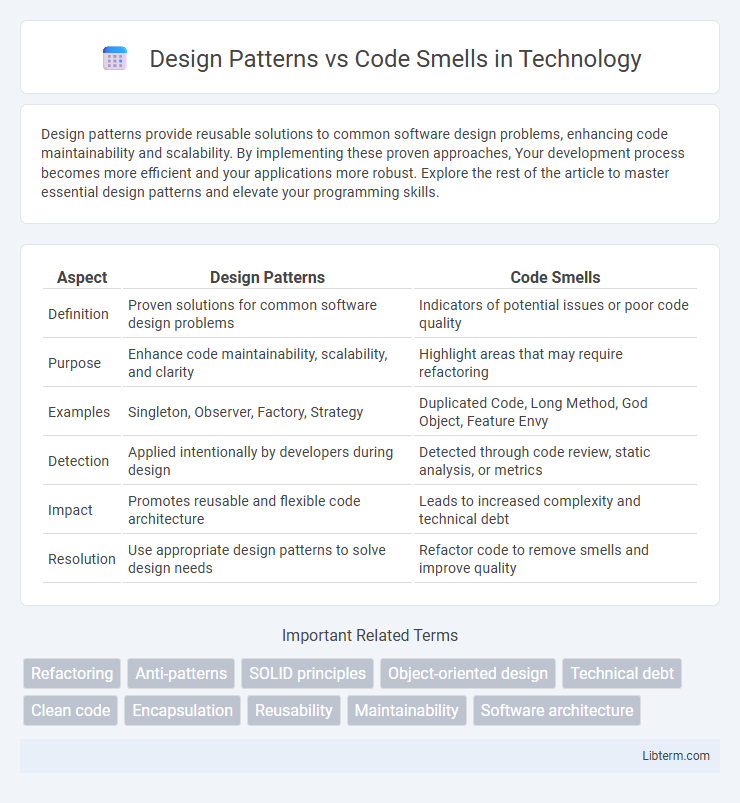Design patterns provide reusable solutions to common software design problems, enhancing code maintainability and scalability. By implementing these proven approaches, Your development process becomes more efficient and your applications more robust. Explore the rest of the article to master essential design patterns and elevate your programming skills.
Table of Comparison
| Aspect | Design Patterns | Code Smells |
|---|---|---|
| Definition | Proven solutions for common software design problems | Indicators of potential issues or poor code quality |
| Purpose | Enhance code maintainability, scalability, and clarity | Highlight areas that may require refactoring |
| Examples | Singleton, Observer, Factory, Strategy | Duplicated Code, Long Method, God Object, Feature Envy |
| Detection | Applied intentionally by developers during design | Detected through code review, static analysis, or metrics |
| Impact | Promotes reusable and flexible code architecture | Leads to increased complexity and technical debt |
| Resolution | Use appropriate design patterns to solve design needs | Refactor code to remove smells and improve quality |
Understanding Design Patterns
Design patterns are reusable solutions to common software design problems that enhance code maintainability, scalability, and readability. Understanding design patterns enables developers to implement best practices that prevent code smells, which are indicators of poor design or potential issues in the codebase. Mastery of design patterns like Singleton, Observer, and Factory empowers teams to create robust architectures and reduce technical debt.
Defining Code Smells
Code smells are indicators of potential problems in the code that may hinder maintainability, readability, or scalability without being outright errors. They often suggest deeper issues like poor design choices, excessive complexity, or violations of best practices that can lead to technical debt. Identifying code smells early helps developers refactor and improve code quality before they evolve into bigger software design problems.
Key Differences: Design Patterns vs Code Smells
Design patterns provide reusable, proven solutions to common software design problems, enhancing code maintainability and scalability. Code smells indicate potential issues or weaknesses in the codebase that may lead to bugs or decreased readability if not addressed. While design patterns promote best practices and structure, code smells highlight areas needing refactoring or improvement to maintain code quality.
Benefits of Using Design Patterns
Design patterns provide proven solutions to common software design problems, improving code maintainability, flexibility, and scalability. They enhance communication among developers by offering a shared vocabulary and reducing complexity, ultimately leading to faster development cycles and fewer bugs. Employing design patterns helps prevent code smells such as duplicated code or tightly coupled components, promoting cleaner and more robust software architectures.
Common Examples of Code Smells
Common examples of code smells include duplicated code, long methods, large classes, and excessive use of primitive data types. These issues often indicate underlying problems in code structure, such as poor modularity or lack of abstraction. Design patterns provide structured solutions to these problems by promoting reusable and maintainable code architectures.
How Design Patterns Prevent Code Smells
Design patterns provide proven solutions to common software design problems, establishing clear, reusable structures that promote maintainable and scalable code. By enforcing best practices such as separation of concerns and modularity, design patterns prevent code smells like duplicated code, tight coupling, and long methods. Implementing design patterns like Singleton, Factory, and Observer reduces complexity and enhances code readability, effectively mitigating the risk of code smells during development.
Refactoring Solutions for Code Smells
Refactoring solutions for code smells often involve applying design patterns to improve code structure, readability, and maintainability. For instance, replacing duplicated code or complex conditional logic with patterns like Template Method or Strategy enhances modularity and reduces technical debt. Utilizing design patterns during refactoring transforms problematic code segments into well-organized, scalable components aligned with best practices.
Best Practices for Applying Design Patterns
Design patterns provide proven solutions to common software design problems, promoting maintainability, scalability, and code reusability when applied correctly. Best practices for applying design patterns include understanding the specific context and problem domain, avoiding overuse or misuse that leads to unnecessary complexity, and ensuring patterns enhance readability and collaboration within development teams. Identifying code smells early helps developers decide when to refactor and introduce appropriate design patterns, resulting in cleaner, more efficient codebases.
When and Why Code Smells Occur
Code smells typically occur when software design deviates from best practices, leading to maintainability and readability issues that hinder scalability and increase technical debt. They arise due to rushed development, lack of refactoring, poor modularization, or misunderstanding of design principles, which compromises code quality and developer productivity. Identifying code smells early signals the need for applying appropriate design patterns to improve structure, promote reusable components, and enhance overall system robustness.
Using Design Patterns to Maintain Clean Code
Design patterns provide proven solutions to common software design problems, enabling developers to write maintainable and scalable code. Utilizing design patterns helps to eliminate code smells such as duplicated code, tight coupling, and complex conditionals by promoting modularity and clear structure. Applying design patterns consistently enhances code readability and reduces technical debt, making long-term maintenance more efficient.
Design Patterns Infographic

 libterm.com
libterm.com